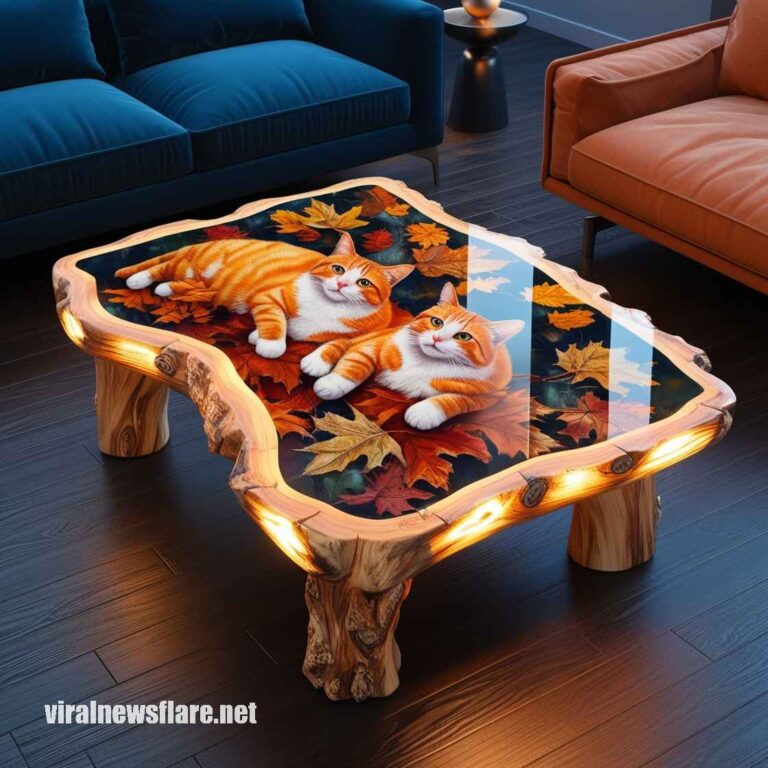In the world of architectural innovation, designers and homeowners alike are continuously seeking new ways to infuse personality, elegance, and bold statements into their living spaces. One such striking innovation is the Snake Shaped Staircase, a design that takes the traditional staircase and transforms it into an artful, sculptural element. This design not only challenges conventional architecture but also embraces fluidity, creativity, and symbolism in a way that is both daring and inspirational.
The Allure of the Snake Shaped Staircase
The Snake Shaped Staircase captivates the imagination with its serpentine curves, mimicking the sleek and sinuous movements of a snake. It is more than just a staircase—it’s a statement piece that elevates interior spaces from mundane to extraordinary. By abandoning the rigid linearity of traditional stair designs, the Snake Shaped Staircase introduces a sense of movement and rhythm that appeals to both the visual and tactile senses. The gentle, undulating curves draw the eye upward, making the ascent feel almost like a journey through an ever-changing pathway rather than a simple change in elevation.
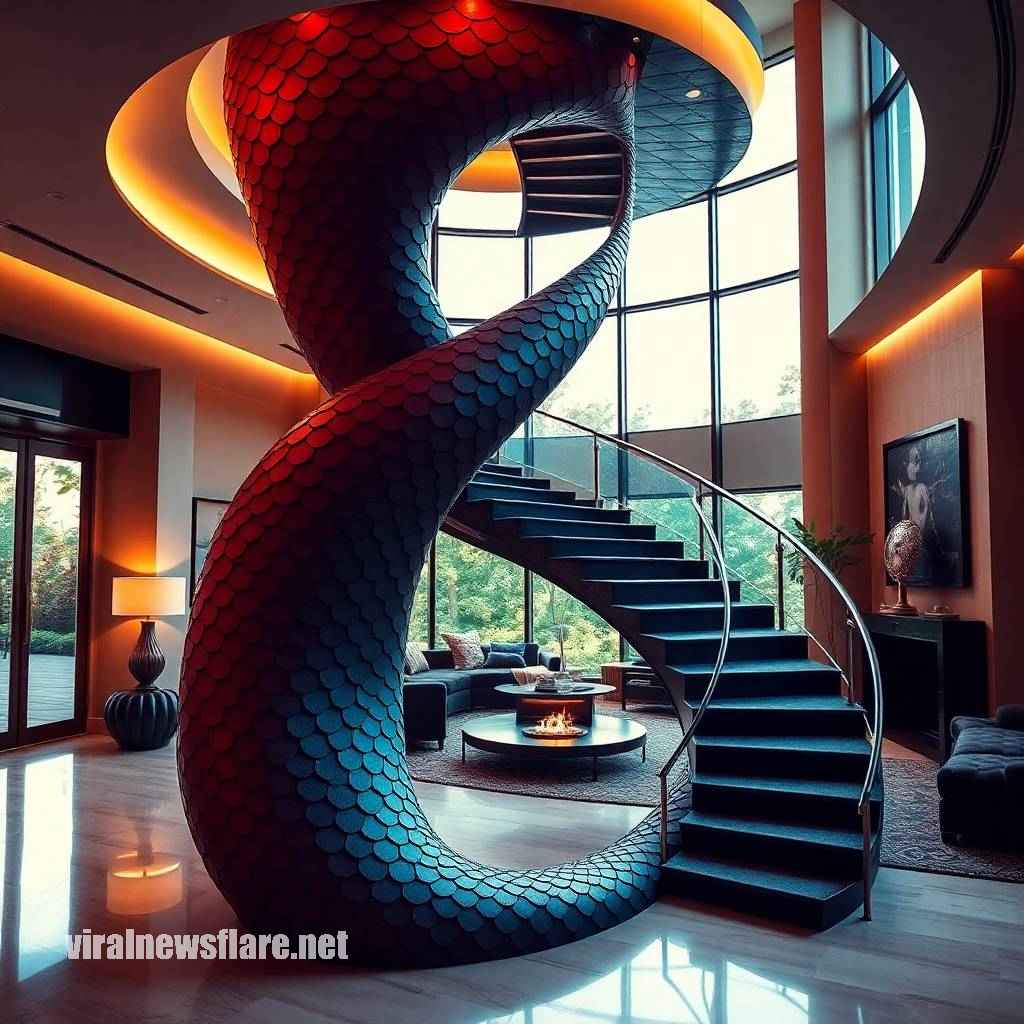
From an artistic perspective, this design embodies a fusion of form and function. It pays homage to nature’s elegance and the timeless symbolism associated with snakes, such as rebirth, transformation, and wisdom. The Snake Shaped Staircase becomes a narrative device within the architecture, telling a story that resonates with the occupants and guests alike, offering an experience that is as much about feeling as it is about moving from one level to another.
Historical Context and Symbolism
Historically, serpentine forms have played a significant role in art and architecture. Ancient civilizations often revered the snake as a symbol of healing, transformation, and immortality. Greek mythology, for instance, features the staff of Asclepius, entwined by a serpent, symbolizing medicine and healing. Similarly, various cultures have depicted serpentine forms in their temple architecture, labyrinths, and garden designs, where the winding paths and curves represent the cyclical nature of life and the journey of the soul.
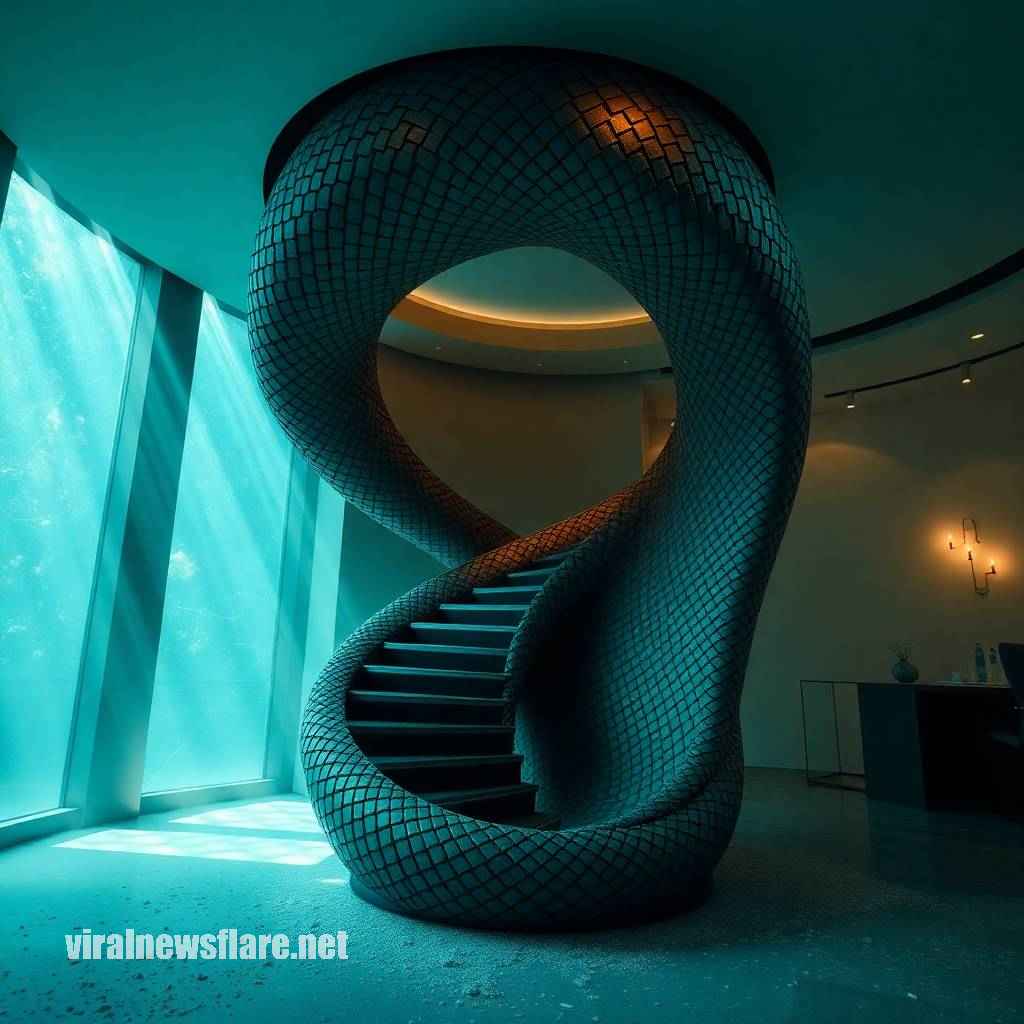
The Snake Shaped Staircase draws from this rich tapestry of symbolism and infuses contemporary spaces with a sense of myth and mystique. Its design taps into deep-seated human associations with the serpent, evoking themes of continuity, growth, and evolution. The fluid and dynamic form of the staircase mirrors the snake’s graceful yet powerful presence in nature, transforming a mere architectural element into a symbolic journey.
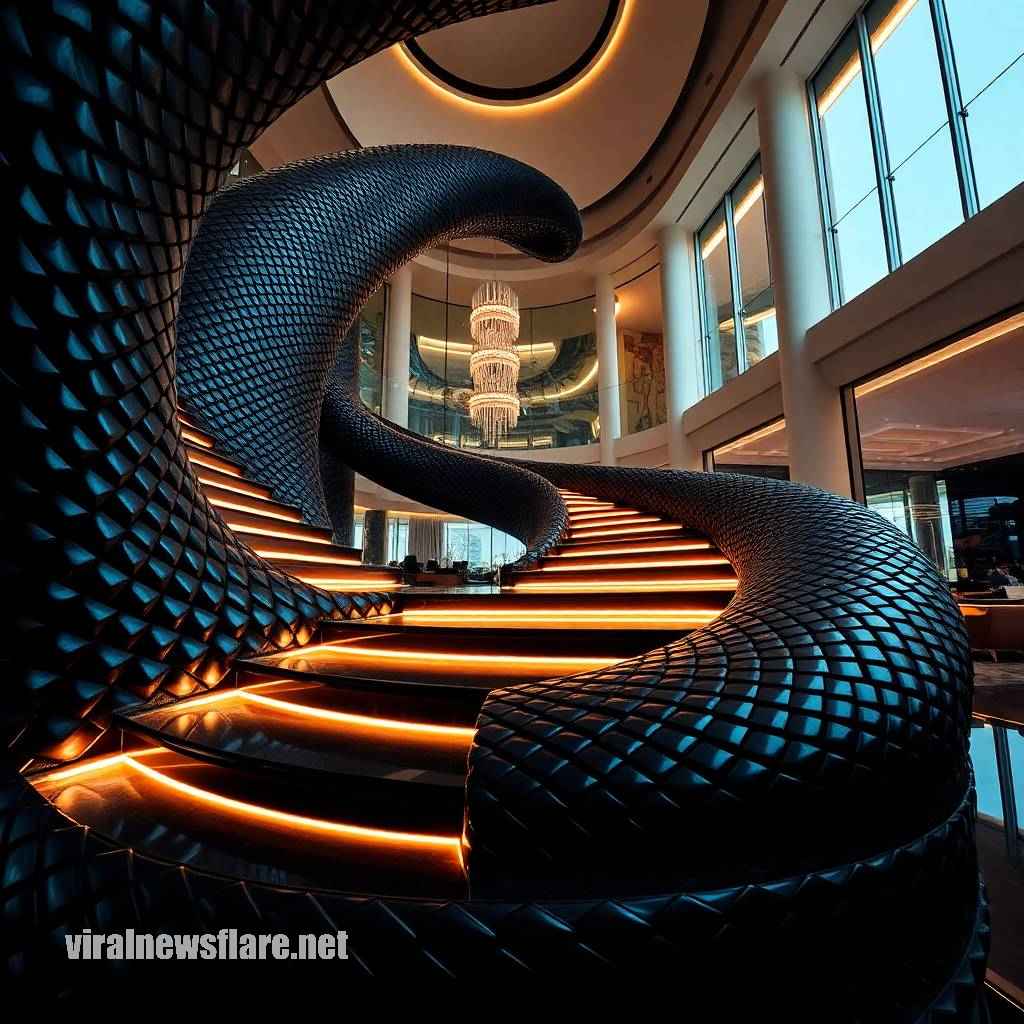
Design Philosophy: Fluidity Meets Functionality
At the heart of the Snake Shaped Staircase is a design philosophy that values fluidity, organic movement, and a seamless integration of aesthetics with practicality. Traditional staircases often follow rigid guidelines: straight runs, consistent risers, and uniform landings. While these designs are functional, they can sometimes feel uninspired or disconnected from the unique character of a space. The Snake Shaped Staircase breaks free from these constraints, offering a more organic approach that adapts to the flow of the environment.
The fluid curves of a serpentine staircase do more than just please the eye; they create an experience. As one ascends or descends the stairs, the subtle twists and turns offer a tactile journey that engages the senses. The design encourages a slower, more mindful pace, allowing individuals to appreciate the craftsmanship and artistry that has gone into creating such a unique piece. In essence, the staircase becomes a journey in itself, a meditative path that invites introspection and a deeper connection to one’s surroundings.
Engineering and Construction Challenges
While the concept of a Snake Shaped Staircase is undoubtedly appealing, turning this vision into a reality involves overcoming significant engineering and construction challenges. Traditional staircases rely on straight, predictable lines that make calculations and construction straightforward. However, the sinuous curves of a Snake Shaped Staircase require advanced planning, precise engineering, and a high level of craftsmanship.
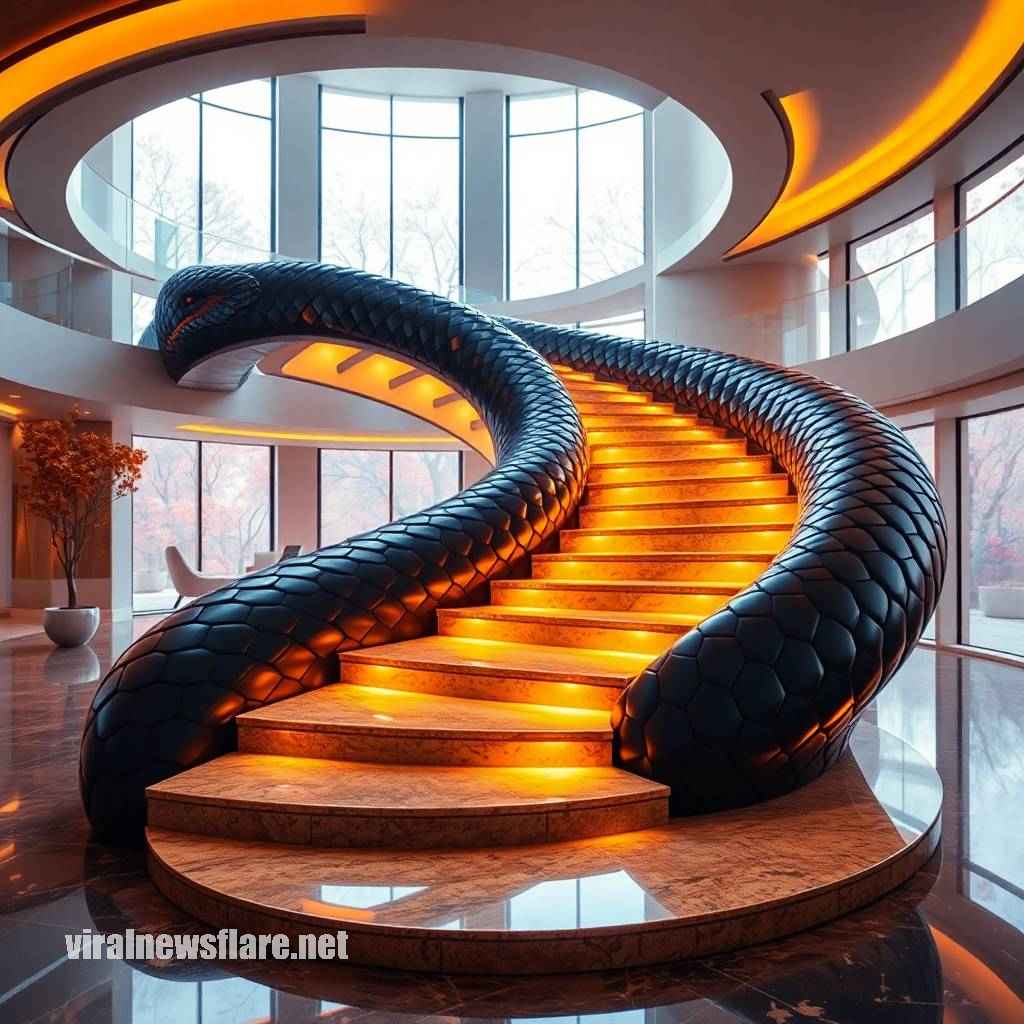
Engineers and architects must work closely to design staircases that not only capture the aesthetic essence of a snake but also meet building codes, safety standards, and ergonomic considerations. The load-bearing calculations become more complex when dealing with non-linear shapes, as the distribution of weight and force changes along the curve. Materials must be chosen carefully to ensure that they can support the structure while allowing for the necessary flexibility in design.
Modern technology, such as computer-aided design (CAD) and 3D modeling, has greatly facilitated the process of designing and constructing these intricate staircases. CAD tools allow designers to simulate the flow of movement, test structural integrity, and visualize how the staircase will fit within a given space. These tools enable the creation of detailed blueprints that guide craftsmen in bringing the Snake Shaped Staircase to life with precision and care.
Material Choices and Aesthetic Considerations
The materials used in constructing a Snake Shaped Staircase are as crucial as the design itself. The choice of material influences not only the structural integrity and durability of the staircase but also its visual impact. Traditional materials like wood, metal, and stone can be used creatively to emphasize the fluid, organic nature of the design.
- Wood: Wood offers warmth, texture, and a natural feel that complements the serpentine form. Hardwood species such as oak, walnut, or mahogany provide both strength and beauty, with their rich grains adding depth and character to the staircase. Carving wood into curved shapes requires skilled craftsmanship, further highlighting the artistry involved in creating the Snake Shaped Staircase.
- Metal: Metals like steel and wrought iron can be molded into elegant curves, offering a modern and industrial aesthetic. When paired with glass or wood elements, metal can create a striking contrast that enhances the visual appeal of the staircase. Metal staircases can be powder-coated or finished in various ways to protect against corrosion and maintain their aesthetic over time.
- Stone: Stone staircases evoke a sense of timelessness and durability. When used in a Snake Shaped Staircase, stone can emphasize the organic, earth-bound qualities of the design. The natural patterns in stone can complement the undulating curves, creating a harmonious blend of form and material.
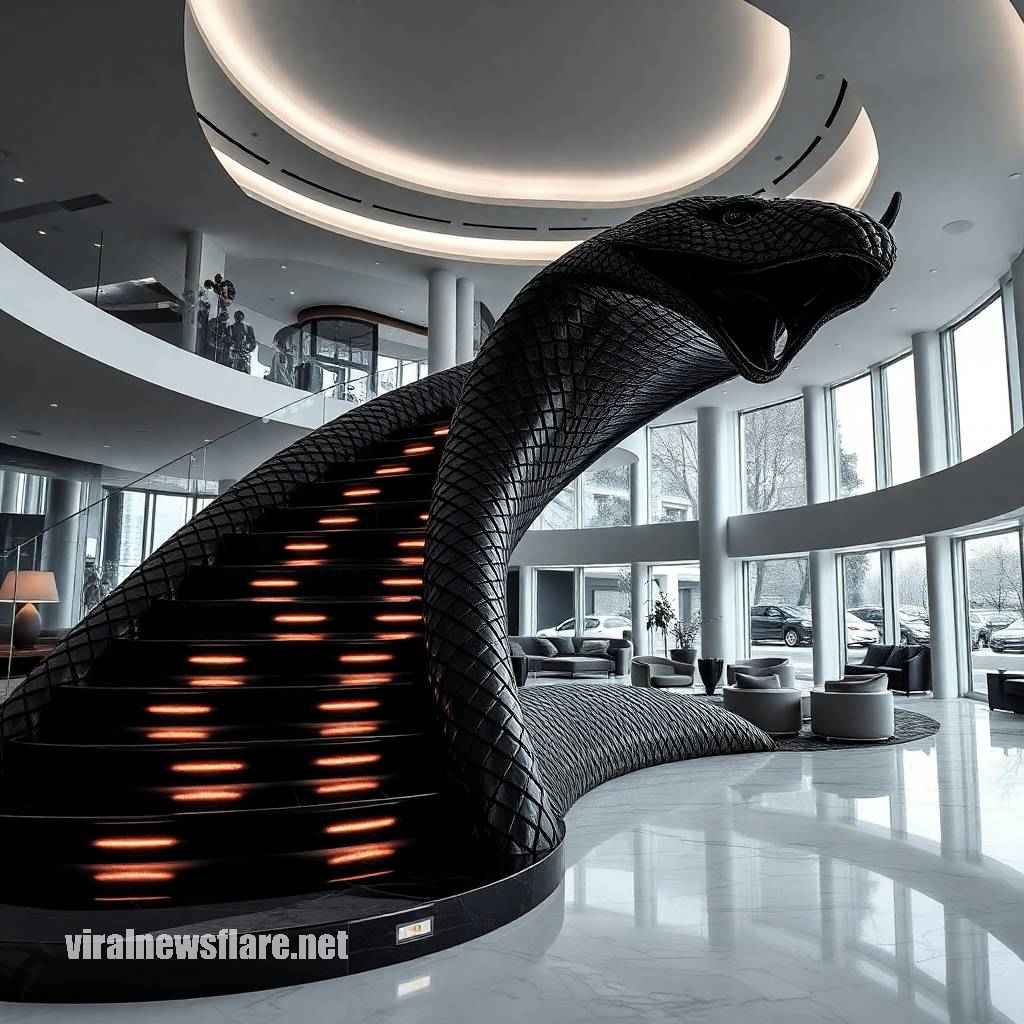
Each material brings its own set of challenges and advantages. The fluid nature of the Snake Shaped Staircase often requires custom fabrication and bending processes, especially for materials like steel. Wood may need to be engineered or laminated to achieve the desired curvature without compromising strength. These considerations ensure that the final product is not only visually stunning but also safe and long-lasting.
Craftsmanship and the Human Touch
The creation of a Snake Shaped Staircase is as much an art as it is a science. Master craftsmen play a pivotal role in translating digital designs and engineering plans into a tangible reality. The intricacy of the curves and the need for flawless joints and finishes call for a high level of skill, patience, and attention to detail.
Artisans work with traditional tools and modern machinery to shape materials into the desired curves. Each curve is carefully measured and cut to ensure that the staircase flows seamlessly from one step to the next. The joinery techniques used must be both aesthetically pleasing and structurally sound, often involving hidden supports and reinforcements that maintain the staircase’s clean and organic appearance.
Moreover, finishing touches such as sanding, polishing, and applying protective coatings are essential to bring out the best in the chosen materials. These finishes not only enhance the visual beauty of the Snake Shaped Staircase but also provide necessary protection against wear and tear, ensuring that the staircase remains a central feature of the home for years to come.
The Role of the Snake Shaped Staircase in Interior Design
Integrating a Snake Shaped Staircase into a living space goes beyond the staircase itself—it influences the entire interior design scheme. Its bold and unconventional form demands attention and sets the tone for the rest of the decor. The staircase can serve as a focal point in a room, drawing the eye and creating a sense of drama and movement.
Interior designers often use the staircase as a starting point for a cohesive design narrative. The curves and flowing lines of the Snake Shaped Staircase can be echoed in other elements of the space, such as furniture, lighting fixtures, and decorative accents. For example, circular or curvilinear sofas, organically shaped coffee tables, and flowing drapery can complement the staircase, creating a harmonious and unified aesthetic.
Lighting plays a crucial role in highlighting the unique features of the Snake Shaped Staircase. Strategically placed lights can accentuate the curves and shadows, adding depth and dimension to the space. Whether using recessed lighting, pendant lights, or LED strips, the goal is to enhance the visual impact of the staircase and create an inviting ambiance.
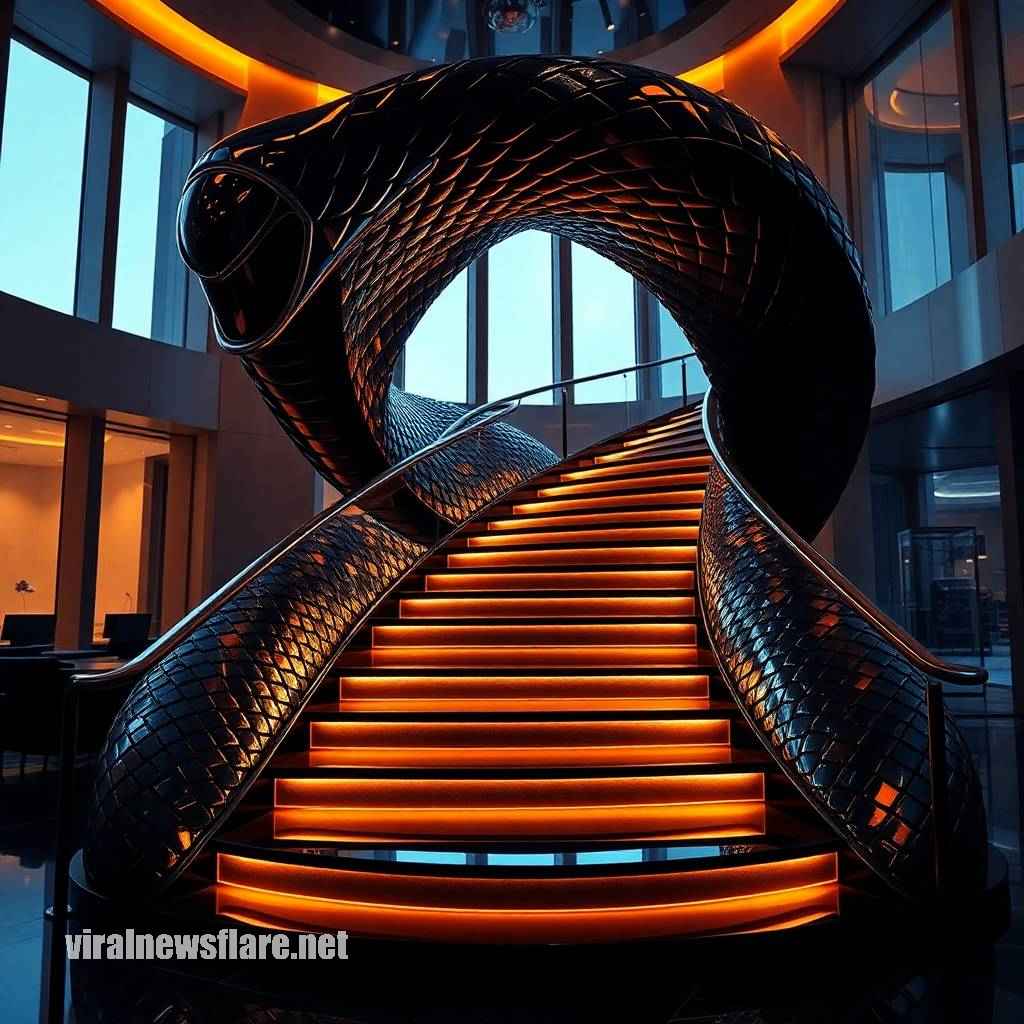
The color palette and material finishes chosen for the staircase can also influence the overall feel of the room. A dark, polished wood staircase may evoke a sense of sophistication and tradition, while a metal staircase with a sleek finish might lend a modern, industrial vibe. The Snake Shaped Staircase thus becomes a bridge between different design styles, capable of adapting to and enhancing various interior aesthetics.
Symbolic and Cultural Resonance
The snake is a powerful symbol in many cultures, representing concepts such as rebirth, regeneration, protection, and transformation. The Snake Shaped Staircase taps into these symbolic meanings, embedding a deeper narrative within a functional architectural element. As one ascends or descends the staircase, there is a metaphorical journey—leaving behind the old and moving towards transformation and new beginnings.
In some interpretations, the serpentine form can symbolize a path of enlightenment or a journey through life’s challenges, much like the twists and turns one encounters along a winding path. This symbolic dimension can add an element of mysticism to the space, inviting contemplation and reflection. It turns a simple architectural feature into a storybook element, where each step signifies progress and the promise of transformation.
For those who appreciate cultural symbolism and storytelling through design, the Snake Shaped Staircase offers a rich tapestry of meanings. It becomes more than just a way to traverse between floors; it becomes an experience, a journey that resonates on an emotional and intellectual level.
Customization and Personalization
One of the greatest advantages of adopting a Snake Shaped Staircase in a home or commercial space is the degree of customization it allows. Unlike standard staircases that follow strict templates, a serpentine staircase can be tailored to fit the specific dimensions, style, and aspirations of the space and its inhabitants. Architects and designers can modify the pitch, height, width, and curvature to perfectly align with spatial requirements and aesthetic preferences.
Customization extends beyond just the shape of the staircase. Designers can incorporate bespoke railings, balustrades, and decorative elements that reflect the personality and tastes of the owners. The use of glass, intricately worked metal, or carved wood panels can add layers of meaning and artistry, making the Snake Shaped Staircase a truly one-of-a-kind feature.
For instance, a homeowner with an affinity for nature might opt for a design where the railing mimics the scales of a snake, or the steps themselves are interwoven with organic patterns. In a corporate setting, the staircase could be designed to reflect the company’s values of innovation, adaptability, and forward-thinking, using modern materials and sleek lines to create an impressive first impression for visitors and employees alike.
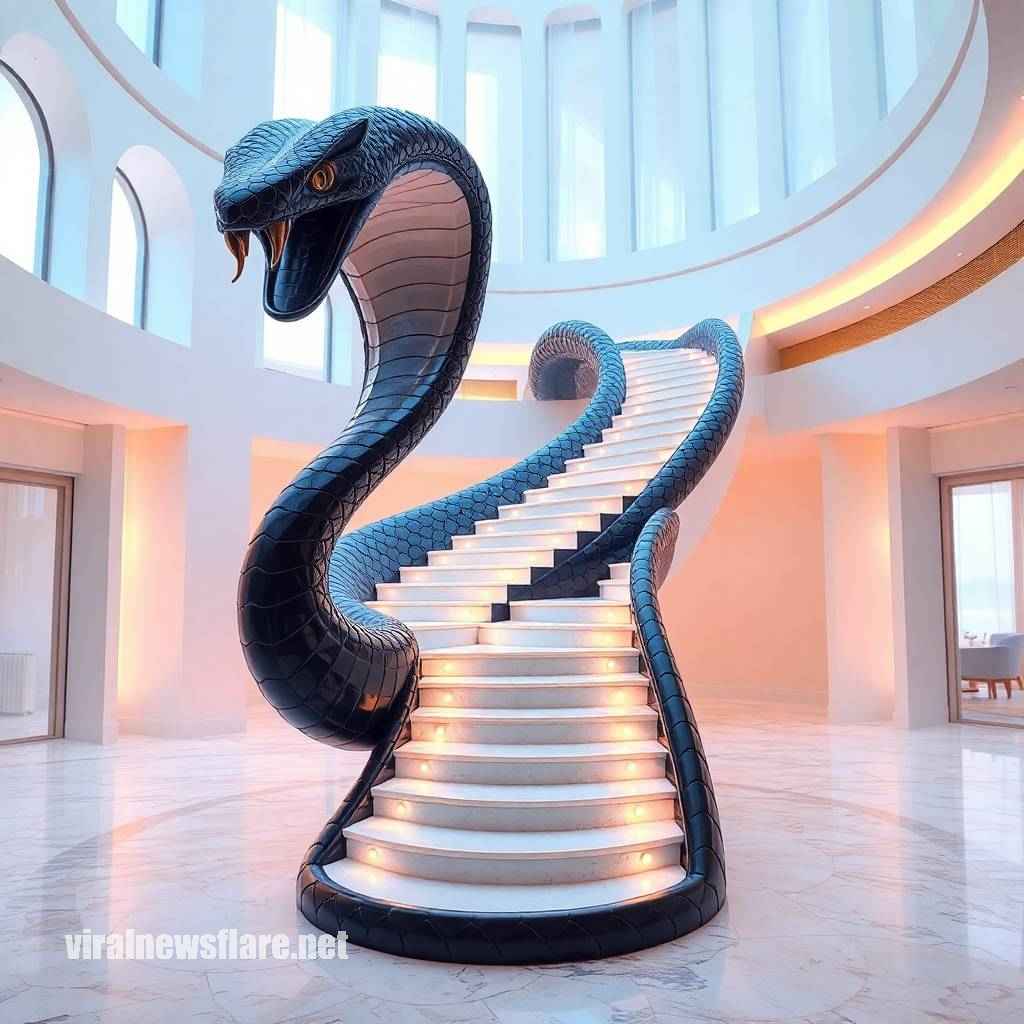
Practical Considerations and Space Optimization
While the Snake Shaped Staircase is undoubtedly a work of art, it also serves practical purposes. One of the most significant benefits of this design is its potential for space optimization. The serpentine form can conform to irregular spaces, making it an ideal solution for homes or buildings where traditional straight staircases would be difficult to fit.
The flexibility in design means that a Snake Shaped Staircase can occupy a smaller footprint on the floor while offering the same, if not greater, functionality compared to a conventional staircase. Its curved form allows for a more organic flow between floors, reducing wasted space and creating an intuitive path that enhances the usability of the area.
Moreover, the design of a Snake Shaped Staircase often incorporates open risers or transparent elements such as glass balustrades, which contribute to a feeling of lightness and openness. This can be particularly beneficial in smaller spaces where a sense of airiness and freedom is desired. The design can be adapted to different building codes and safety standards, ensuring that while the staircase is bold and artistic, it remains safe and functional for everyday use.
Safety and Maintenance
Safety is a paramount concern in any staircase design, and the Snake Shaped Staircase is no exception. Its curved nature requires careful planning to ensure that each step is comfortable to navigate and adheres to safety codes regarding tread depth, riser height, and handrail placement.
The fluid curves, while aesthetically pleasing, must not compromise safety. Designers must consider factors such as the angle of ascent, the width of the stairs, and the placement of lighting to ensure that users can traverse the staircase without risk of falls or injuries. The handrails, often intricately designed to echo the snake motif, should provide secure and ergonomic support, guiding users through the twists and turns with confidence.

Maintenance considerations for a Snake Shaped Staircase vary depending on the materials used. Wood may require periodic refinishing to maintain its luster and prevent wear, while metal elements might need treatment to protect against rust and corrosion. Regular cleaning and inspections are essential to ensure that the structural integrity and safety features of the staircase remain in top condition. Because of its unique design, maintenance might require specialized knowledge, so homeowners should work with professionals familiar with serpentine structures to uphold the staircase’s beauty and functionality.
Integration with Modern Architecture
In modern architecture, the emphasis is often on open spaces, fluid lines, and a seamless connection between indoor and outdoor environments. The Snake Shaped Staircase fits perfectly into this aesthetic, offering a sculptural element that complements open-plan designs and organic landscaping. Its curves can lead the eye to focal points in the home, such as a stunning piece of art, a panoramic window, or a cozy reading nook.
By integrating the Snake Shaped Staircase with modern materials like glass, steel, and sustainable wood, architects can create a harmonious blend of tradition and innovation. The staircase can be positioned to maximize natural light, creating interplay of shadows and reflections that change throughout the day. This dynamic interplay adds a layer of enchantment to the living space, making the staircase not just a conduit between floors, but a living part of the home’s identity.
Future Trends: The Evolution of Staircase Design
As we look to the future of design, the Snake Shaped Staircase is likely to inspire further innovations. Its bold departure from tradition encourages designers to explore other organic and biomorphic forms, ushering in a new era of architecture where functionality and art intersect seamlessly. The incorporation of smart home technology, sustainable materials, and adaptive design principles will continue to evolve the concept of the staircase from a mere structural necessity to a central feature of architectural storytelling.
The Snake Shaped Staircase represents more than just a functional structure—it is a bold twist on traditional stair design that brings together art, engineering, symbolism, and functionality in a single, breathtaking piece. Its serpentine curves evoke a sense of fluidity, movement, and timeless elegance, transforming the simple act of moving between floors into a journey of beauty and meaning.
From its historical roots in mythology to its modern applications in sophisticated interiors, the Snake Shaped Staircase challenges us to rethink how we experience space and design. It invites us to embrace boldness, to seek beauty in curves, and to appreciate the artistry that can be woven into the fabric of our daily lives. As architecture and design continue to push boundaries, the Snake Shaped Staircase stands as a testament to the power of innovative thinking and the endless possibilities that arise when we dare to twist tradition.
